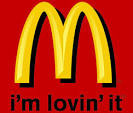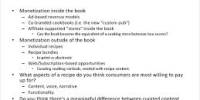COMPANY BACKGROUND:
As a company, Mcdonalds was first introduced in Des Plaines, Illinois in 1955. This was the very first Mcdonalds restaurant, which all started in San Bernardino, California in 1954 when Ray Kroc approached the McDonald brothers with a business proposition to start a new company. In 1965 McDonald’s went public and was later, in 1985 added to the Dow Jones Industrial Average. (www.mcdonalds.com) The company has gone through quite a few changes with its changing CEO’s over the years, but the company seems to be on track with CEO Jim Skinner, named in 2004. Skinner was named the new CEO just in time to clean up after McDonald’s first ever quarterly loss. He succeeded by showing that McDonald’s revenue had climbed 11% during 2006 and net profits had climbed 36%.
SWOT ANALYSIS:
STRENGTHS: Jim Skinner had to clean up a big mess after the 2003 slump, and did so by coming up with a strategy to turn everything around. His strategy had to consist of staying competitive with the numerous other fast-food restaurants popping up all over the world. In order to maintain this, they had to reorganize the way they presented themselves to the community. Jim Skinner did so by cleaning up the customer service, cleaning up and modernizing the physical buildings, and changing the menu to the changing tastes of their customers. McDonald’s also introduced their slogan “I’m Loving It” to reach out to the younger customers. The advertising is very much targeted toward teens and young adults.
WEAKNESSES: The first weakness was the changing of three different CEOs in only one year. These were unexpected changes, but all had to be dealt with by the newest CEO Jim Skinner, and directly after McDonald’s first ever quarterly loss in 2003. The second weakness is an issue with trying to find new and exciting things to put on the menu to bring in new customers. Many of today’s fast-food customers are making different kinds of foods, like Chinese and Mexican food, normal to the everyday menu.
OPPORTUNITIES: McDonalds has many opportunities to change its look, menu, and customer service. McDonald’s started building newer building incorporating the arch, along with more modern furnishings. The menu has changed by adding more breakfast items and introducing the McCafe in certain areas. It has also added more health concerned items such as the Asian salad and Premium white chicken.
THREATS: McDonald’s biggest threat is competition. Wherever there is a McDonald’s, there are at least 3 other fast-food restaurants near it. It constantly has to advertise what makes them unique to other fast-food places, which means there always has to be something different about them than anybody else. Just the fact that McDonald’s was the first company to go big with their burgers does not necessarily help them today. Every customer is looking for a new experience and new products to keep them excited with what they are eating and where they are going to eat, and with so many choices, it is hard for McDonald’s to compete with. (McDonald’s 2007)
ANALYSIS VIA PORTER’S FIVE FORCES MODEL:
THREAT OF NEW ENTRANTS: The threat of new entrants for McDonald’s and the fast-food industry is low. With so many different kinds of fast-food restaurants already in the industry, entering at this point would cause struggle for the new entrant. (McDonald’s 2007)
BARGAINING POWER OF SUPPLIERS: According to Siehoyono (2005), there are 3,700 new outlets being built each year in the U.S., meaning the power of suppliers is not an issue for McDonald’s.
BARGAINING POWER OF BUYERS:
Consumers have more power over buying McDonald’s products because they can demand what type of products they want to see from them. Today, consumers are demanding healthier food and beverage choices from fast-food restaurants such as McDonald’s. After the documentary film “Supersize Me” by Morgan Spurlock came out in 2004, McDonald’s had to reclaim its name by showing America that their company cares about the health of their customers and cut out their “supersize” program.
SUBSTITUTE PRODUCTS/SERVICES:
In the fast-food industry, including McDonald’s, the threat of substitutes is greater now more than ever with the convenience food industry growing. More convenience food stores are offering similar products as the fast-food restaurants. The convenience store / gas station, Quik Trip, sells many food items such as hot dogs, egg rolls, pizza stuffed breadsticks, and countless beverage choices.
COMPETITIVE RIVALRY:
According to Siehoyono (2005), “fast casual” food chains such as Subway are tougher competition to the fast-food chains in both the U.S. and international industries. Some franchisers were also complaining that McDonald’s was granting too many franchisees too close to each other and actually stealing business away from each other.
STRATEGY USED:
Mcdonalds has tried both cost leadership and differentiation as strategies to outdo the competition. Mcdonalds is known for their low price product line and has been competitive with other businesses in the industry. A representation of differentiation is their dollar menu. They were one of the first in the industry to do a very low-cost smaller menu of items on their product line that cost only $1. As soon as this came out and was advertised, many of the other fast-food businesses started something similar to compete. There is only so much a business can do with a low-cost strategy before it starts losing money. This only leaves differentiation or a focus strategy to use. Focus strategies would not work as well in this industry mainly because their product line is similar in all areas of the world because that is what they are known for. McDonald’s has to stay true to what it started as and not fly too far away from its roots. McDonald’s has also tried a differentiation strategy with different products like the McRib or the Big Mac.
ISSUES AND CHALLENGES:
Mcdonalds competitive advantage is their differentiation. Their products’ flavors and names are exclusive to them and the brand of Mcdonalds is distinguished by the looks and tastes of their foods. If somebody set a row of burgers and fries each from a different restaurant, I could pick out exactly which one is McDonald’s burgers and fries. They have distinguished themselves this way for years and this will continue, but the tastes of the customers may change. This will be the problem. Mcdonalds will have to answer to the needs and wants of their customers to keep them satisfied and coming back for more. Right now in the industry life cycle, McDonald’s is a mature company focusing on competition and their product line’s survival. The culture of McDonald’s is keeping their customers happy and to do whatever they can to create a wider customer base along with a product line that satisfies any taste. I think McDonald’s customer service is not consistent. I have personally experienced many different stores and some have very good customer service and some are not very good at all. The stores’ cleanliness and overall appearance also is not consistent.
COURSE OF ACTION RECOMMENDED: If I were in a position to make a decision for this company, first I would require all management and supervisory positions to go through company training. They would then be required to test their employees on customer service and sales skills. In doing this kind of training all branches would have a better chance of happy customers and exceptional customer service. Employees also need to be treated with respect and importance for them to want to do well in their position. Some kind of incentives plan needs to be put into action for their employees. Older buildings need to be updated so customers feel comfortable and clean while dining in.
OPINION: I think reading case studies is already interesting because it teaches you how the company works and how it became what it is today. Anybody can tell just from reading a case study whether it is a successful business and what their issues are. I thought that writing a case study analysis helped understand how a company operates considering all challenges and opportunities.
References
Dess, G., Lumpkin, G. & Eisner, A. (2008). Strategic Management (4e). Boston:McGraw-Hill Irwin.
Siehoyono, L. (2005). The McDonald’s Case: Strategies for Growth.
McDonald’s History. (2007). Available on www.mcdonalds.com. Accessed on September 17th, 2008.















